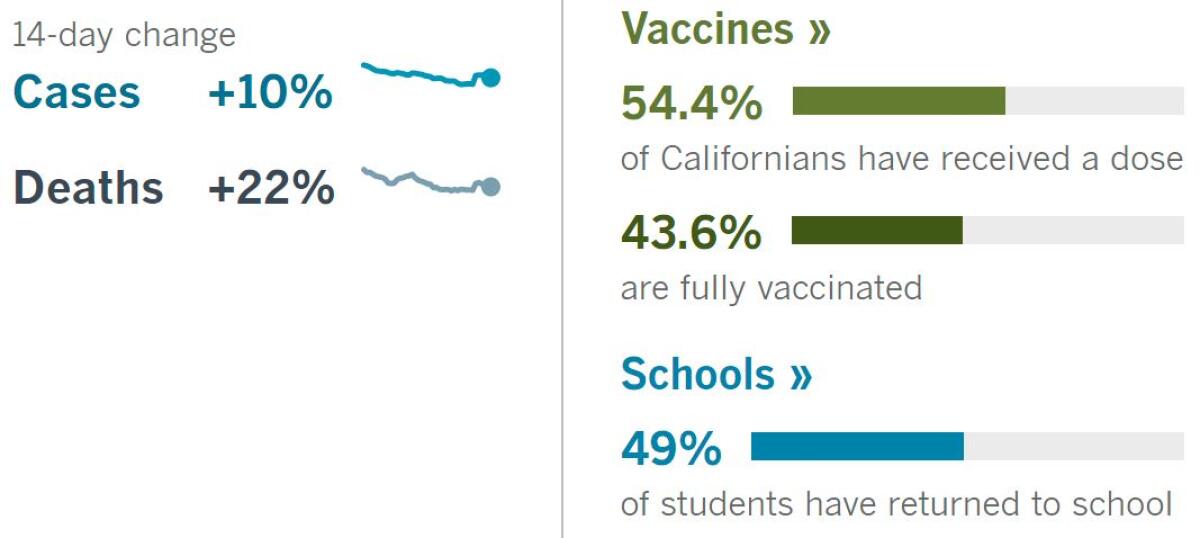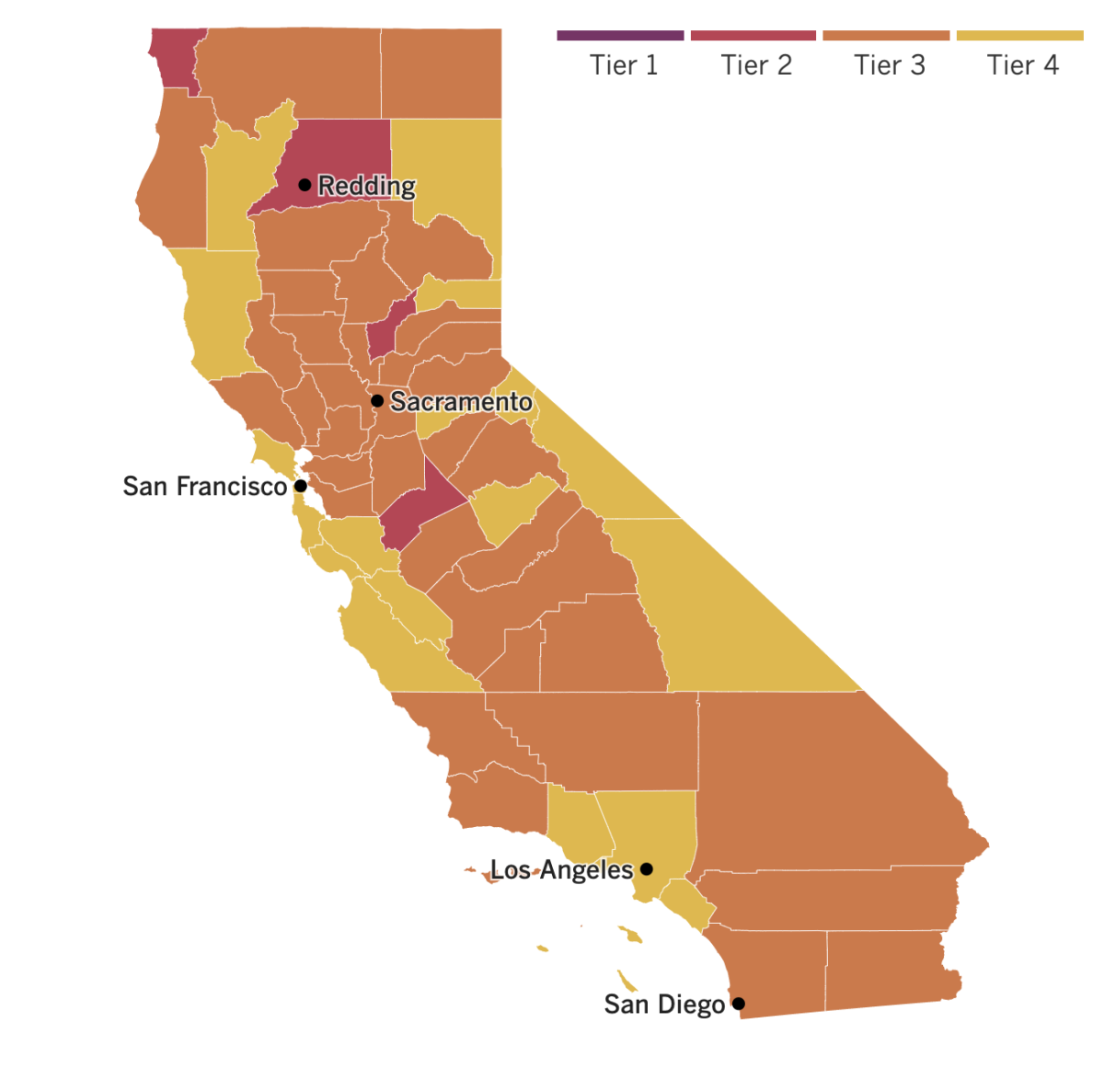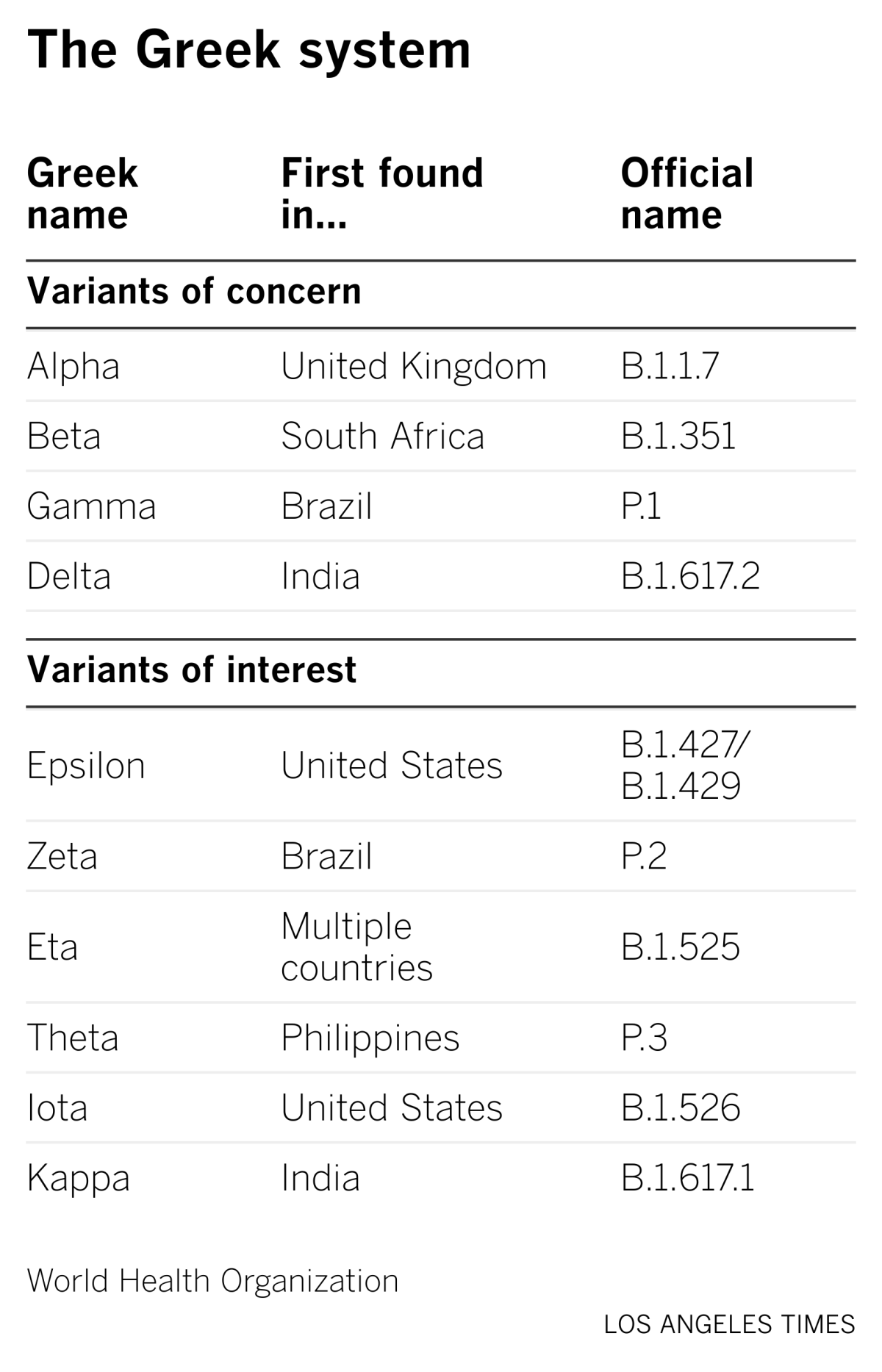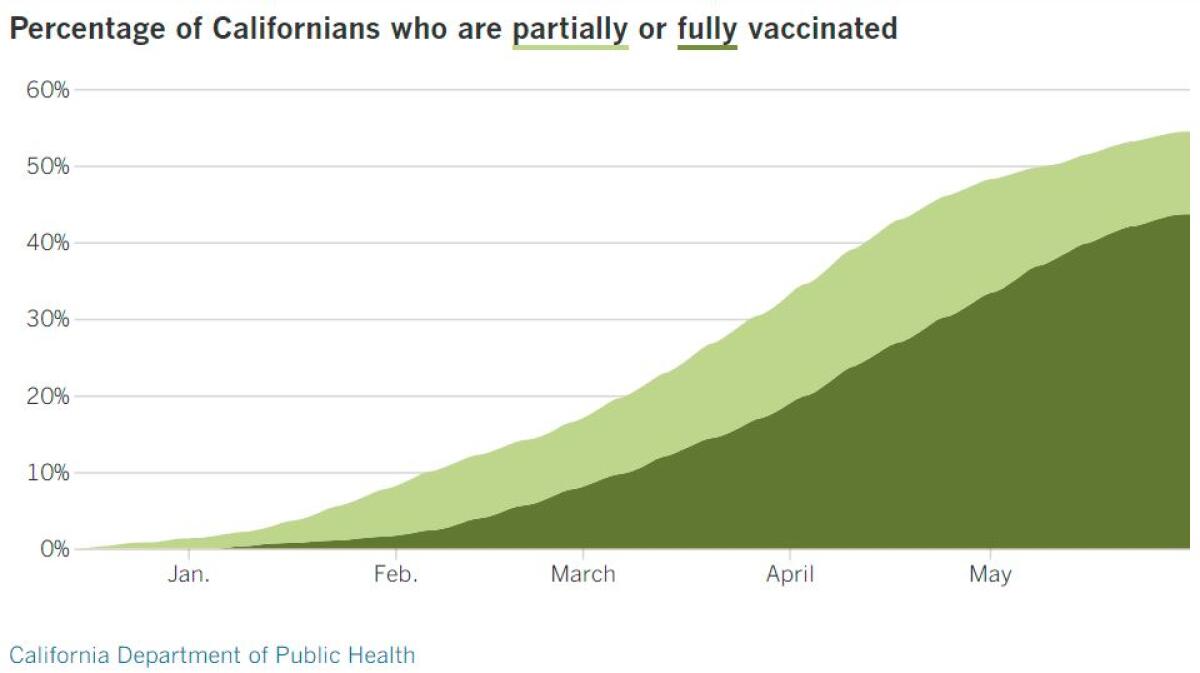Coronavirus Today: Is Las Vegas coming back?
- Share via
Good evening. I’m Russ Mitchell, and I’m a tech reporter up in the Bay Area. I’ll be bringing you the pandemic news for these next two weeks before the California economy reopens. It’s Tuesday, June 1, and here’s what’s happening with the coronavirus in California and beyond.
Tomorrow is the last day of the school year in my household, and my 15-year-old daughter will soon be off on a trip to Vegas. It’s not what you may think, dear readers: She’s going with her mom. She knows she’s too young for the casinos. She doesn’t like being near smokers and can’t comprehend why anyone would get a tattoo. She’ll be fully vaccinated. So I’m not worried — well, not too worried.
She’s headed to the Mirage as a black-belt competitor in the U.S. Taekwondo Grand Prix tournament, which draws kids from all over the country. The fact that so many parents are now willing to put their kids on a plane to Sin City is powerful anecdotal evidence that a comeback is indeed at hand.
The Year of COVID has been miserable for Las Vegas’ tourist-dependent economy. As detailed by my colleague Kurtis Lee, the city’s bustling economy got slammed last year. Its unemployment rate soared to near 30%, up from 4% before the pandemic, as gambling revenues took a 45% hit.
Lee’s well-crafted story tells the tale through the lives of everyday workers and small-business proprietors hit hard by the crisis.
There’s Bernard Sykes, a bartender at the Rio hotel who likes to tell stories about celebrities he’s met while serving drinks for $14 an hour. He got laid off at the start of the pandemic and has been out of work since.
There’s Charolette Richards, owner of A Little White Wedding Chapel, where Bruce Willis married Demi Moore. The chapel’s drive-through service window kept the place afloat.
There’s Yaneth Chavez, mother of two young children, who prepped food at the Red Rock Casino for $18 an hour before she was laid off on May 1 last year. She found an on-call job working events at Allegiant Stadium, the new home for the NFL’s Raiders, but the sporadic nature of the job sometimes forces trips to the food banks.
Las Vegas was closed for two months and has been in a very slow reopening mode ever since. It’s throwing the doors wide now, and hoping people will show up. The more that do, the more jobs there’ll be. It is, in a sense, a test of America’s ability to reclaim itself.
I’m hoping the people who need jobs get hired back, that the taekwondo tournament is a sign that the city’s on its way back to economic health, and that my daughter wins a gold medal — or at least does her best.
By the numbers
California cases, deaths and vaccinations as of 5:52 p.m. Tuesday:

Track California’s coronavirus spread and vaccination efforts — including the latest numbers and how they break down — with our graphics.

Across California
No doubt, Walt Disney Co. can hardly wait for Disneyland’s capacity limits to be lifted, allowing the free-spending fanatics to return in full force.
Disney’s short-term loss can be your gain. The Happiest Place on Earth is now operating at 35% of its usual capacity, and that’s making those who get in even happier than usual. “We get to ride all the rides twice today,” said Stephanie Bush of San Diego, who took advantage of the smaller crowds to try attractions she normally wouldn’t have time for.
Los Angeles Times writer Christi Carras visited the park and its next-door neighbor, California Adventure, recently and matched her wait times against pre-pandemic averages. The differences are not subtle. Space Mountain? A line that used to last for 65 minutes now takes just 5 minutes and 56 seconds. Alice in Wonderland? That line dropped from 33 minutes then to 63 seconds now. A turn on Radiator Springs Racers previously forced visitors to cool their heels in line for 86 minutes; Carras made it to the front in 13 minutes.
But the most dramatic difference was for a ride called Guardians of the Galaxy: Mission — Breakout! Before the pandemic, guests would have to wait 94 minutes for this attraction; that dropped to just 1 minute and 46 seconds when Carras was there.
If this sounds enticing, enjoy it while it lasts. On June 15, the state will allow out-of-state visitors to return, and crowds can go back to their normal size. That could please certain individuals, such as Brian David of Los Angeles, who told The Times, “I feel like half the ride is the anticipation building up to it … but I have a lot of fond memories of standing in some of the lines.” For him, paradise awaits.
But enough about Disneyland. Let’s get back to work. Wouldn’t it be nice if your workplace could let groups of vaccinated employees take off their masks?
California’s workplace safety board is considering a proposal that would make that possible as long as no unvaccinated people lurked in the crowd. That would be a tall order for stores, restaurants and other businesses where workers interact with the public, so they’ll probably still need to mask up for now.
The new proposal to relax mask and social distancing rules was drafted by the California Division of Occupational Health and Safety, known as Cal/OSHA, and will be a topic of discussion at a board meeting on Thursday. If the board endorses it, the state Office of Administrative Law will have 10 days to approve it.
The sooner people get vaccinated, the sooner everyone will be allowed to go mask-free. But while more than 70% of Californians 18 and older have received at least one shot, the pace of vaccinations has slowed way down.
At the peak, providers around the state were administering about 400,000 vaccine doses per day. Over the last week, the average was about 141,000 shots per day, according to data compiled by The Times.
“It’s those first doses, those first shots, that are way down,” Gov. Gavin Newsom said. With fewer people beginning the vaccine regimen, an even larger drop-off is on the horizon, he added: “You can see that cliff coming in the next week or two.”
Meanwhile, as we near the end of the state’s tiered reopening system, more counties moved Tuesday into less restrictive tiers. Marin, Monterey, San Benito and Ventura counties just joined the least-restrictive yellow tier, in which counties can let most businesses operate indoors with some modifications, and another four — Nevada, Sacramento, San Joaquin and Solano — have progressed into the orange.


See the latest on California’s coronavirus closures and reopenings, and the metrics that inform them, with our tracker.
Consider subscribing to the Los Angeles Times
Your support helps us deliver the news that matters most. Become a subscriber.
Around the nation and the world
Do you confuse the B.1.1.7 coronavirus variant with B.1.351? What about P.1, P.2 and P.3?
Thanks to the World Health Organization, you now have one fewer thing to worry about. The global health agency has unveiled a new variant naming system that replaces the letter-dot-number framework with a much simpler one based on Greek letters.
B.1.1.7, first identified in the United Kingdom and often referred to as “the U.K. variant,” becomes Alpha, and B.1.351, which you may know as “the South Africa variant,” is now Beta. And the really confounding pair from California known as B.1.427/B.1.429 now goes by Epsilon.
Scientists frown on naming pathogens and diseases after places — they say it can be stigmatizing. (In their book, the Spanish flu should be known as the 1918 H1N1 virus.) But the Greek letter system is a tacit acknowledgement that their way of referring to viral variants needed some work.
So far, four variants of concern and six variants of interest have earned Greek letters. If we get to the unfortunate point where the list of variants is longer than the Greek alphabet, WHO said it will come up with a new naming scheme. That would avoid a scenario in which fraternities and sororities find themselves sharing names with viruses.

For now though, the variants do keep coming. Yet another made its appearance several days ago in Vietnam.
The new variant is a hybrid of the Alpha and Delta variants. Laboratory tests suggested it might spread more easily than other versions of the virus, the Vietnamese health minister said.
A recent surge has spread to 30 of Vietnam’s 65 municipalities and provinces, and the new variant could be to blame, according to the health minister.
Meanwhile in Peru, officials have revised the way they count COVID-19 deaths. As a result, the country’s toll now stands at 180,764 — more than double the previous tally.
Under the old rules, only those who “had a positive diagnostic test” were classified as having died of COVID-19. Under the new rules, the criteria have been expanded. The change means that Brazil and Mexico are the only Latin American countries with more COVID-19 deaths.
While the virus surges in parts of Southeast Asia and Latin America, it is waning across Europe as vaccination rates accelerate. The travel industry has its fingers crossed that infections, hospitalizations and deaths will continue their downward trend, rescuing the summer tourist season.
Speaking of vaccines, pregnant women who are unsure whether to get vaccinated against COVID-19 received an assurance from the head of the National Institutes of Health that the two mRNA vaccines “appear to be completely safe” for expecting mothers.
Dr. Francis Collins, the NIH director, explained in a blog post Tuesday that pregnant women had been excluded from initial clinical trials of the vaccines made by Pfizer-BioNTech and Moderna. But he said two new studies involving small groups of pregnant women indicate the two vaccines are “safe and effective in pregnancy, with the potential to benefit both mother and baby.”
One study found that women who were pregnant or were breastfeeding produced coronavirus antibodies that were able to fight off some troubling variants. The antibodies were also detected in cord blood and breast milk, suggesting that infants received some of the vaccines’ protection too.
The second study also found that the vaccines worked properly in pregnant women and caused no unexpected damage to the placenta, Collins wrote.
Your questions answered
Today’s question comes from a reader who wants to know: Why does your vaccine tracker graphic show the percentage of all Californians who have been vaccinated instead of the percentage of people who are eligible?
Several of you have written to us asking about how we’re tracking vaccinations, and what the percentages shown in our trackers reflect. After all, as some of you have pointed out, the vaccine isn’t even available to kids under 12, so we might get a better handle on how the rollout is going if we focus on vaccinations among those who are eligible to receive it.
This particular reader’s question pertained to a version of the vaccine-tracking graphic that we included in the newsletters a while back. Here’s what that graph looks like based on today’s data:

It may seem silly to focus on the percentage of all Californians vaccinated. But think of that graph not as a gauge of California’s progress toward vaccinating currently eligible groups, but rather as a measure of how far we’ve come toward ending the outbreak.
We are tracking the percentage of all Californians vaccinated to gauge our progress toward herd immunity. Experts anticipate we’ll get there once about 85% of all Americans — including the nation’s 75 million kids — have been vaccinated. When herd immunity is reached, the virus will have a hard time finding new hosts to infect, and the outbreak will sputter to an end.
But that will take a while, since as the reader notes, COVID-19 vaccines are not yet being administered to young children. Although both Pfizer and Moderna are testing their vaccines in children as young as 6 months, results of those tests may not come until fall and the U.S. Food and Drug Administration may not authorize them for young children until late this year or early next.
But we’re getting closer. Already, Pfizer’s vaccine is being administered to kids age 12 and older, and last week, Moderna said its shot works in kids that age too, and that it plans to submit data to regulators early this month.
Vaccines may not carry us to total herd immunity, but the greater the number of people who are vaccinated, the lower the risk that our healthcare system will be overwhelmed by COVID-19. A well-vaccinated population also means less chance of a dangerous new variant taking hold. And immunizing kids will be key to curbing those risks. My colleague Deborah Netburn wrote more last month about why this matters.
We want to hear from you. Email us your coronavirus questions, and we’ll do our best to answer them. Wondering if your question’s already been answered? Check out our archive here.
Resources
Need a vaccine? Sign up for email updates, and make an appointment where you live: City of Los Angeles | Los Angeles County | Kern County | Orange County | Riverside County | San Bernardino County | San Diego County | San Luis Obispo County | Santa Barbara County | Ventura County
Need more vaccine help? Talk to your healthcare provider. Call the state’s COVID-19 hotline at (833) 422-4255. And consult our county-by-county guides to getting vaccinated.
Practice social distancing using these tips, and wear a mask or two.
Watch for symptoms such as fever, cough, shortness of breath, chills, shaking with chills, muscle pain, headache, sore throat and loss of taste or smell. Here’s what to look for and when.
Need to get tested? Here’s where you can in L.A. County and around California.
Americans are hurting in many ways. We have advice for helping kids cope, resources for people experiencing domestic abuse and a newsletter to help you make ends meet.
We’ve answered hundreds of readers’ questions. Explore them in our archive here.
For our most up-to-date coverage, visit our homepage and our Health section, get our breaking news alerts, and follow us on Twitter and Instagram.




